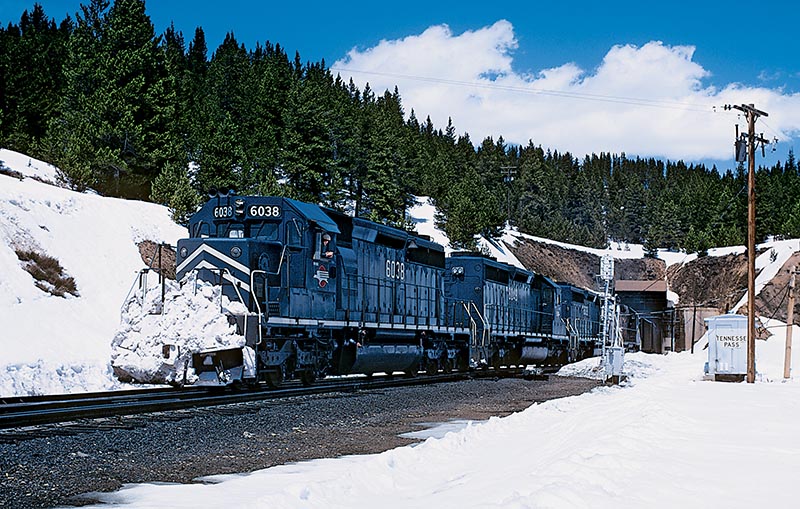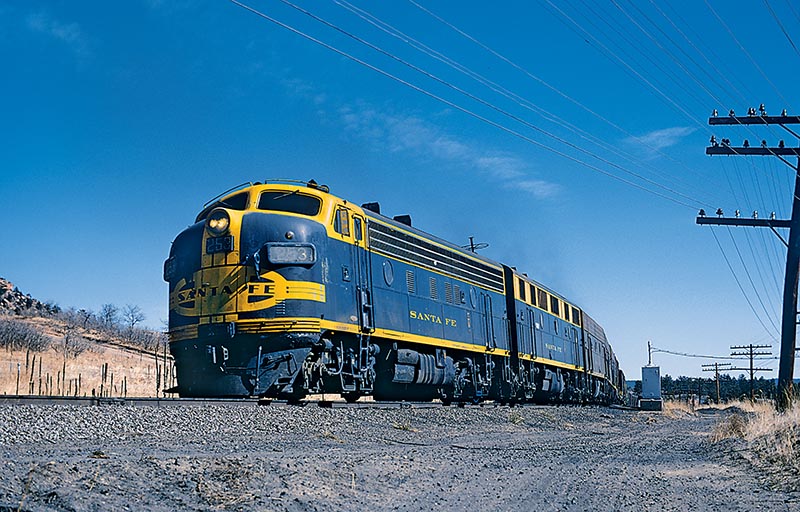 by Robert R. Harmen, D.D.S./photos by the author
by Robert R. Harmen, D.D.S./photos by the author
Rio Grande country, that is. The Denver & Rio Grande Western Railroad. I became aware of the D&RGW during my 15th summer, a relationship that would endure for the next 59-plus years. I also became a Missouri Pacific fan for its final 20 years of existence before being swallowed by Union Pacific. Both Rio Grande and MoPac played major roles in my hometown of Pueblo, Colorado.
Tennessee Pass First Encounter
I had finished my Sophomore year of high school in 1961. My uncle was able to rent a couple of trailers homes at Camp Hale in what must have been June or July. Camp Hale was a former Army base at Pando, Colo., where they trained soldiers for fighting in snow-covered fields of battle. It was an important base during World War II, providing a realistic training ground for the 10th Mountain Infantry Division, who fought in Italy — but by 1961, it was largely abandoned. The Armed Forces Entertainment & Exchange System (AFEES for short) was using a small area in the middle of the base to park a few trailer homes that military personnel could use as a camp site, of sorts. So, we met my uncle Roland and his wife Donna up there and began a weekend in the Rockies. I was soon to become an eyewitness to the exciting drama occurring up on the mountainside above the camp.

On September 15, 1977, an empty train dispatched out of Grand Junction on the North Fork Branch is seen climbing to Roger’s Mesa from the west side. This is an extremely arid area looking a lot like a moonscape, so radically different from the top of the mesa directly behind us, which is a lush green with many orchards and fields.
Uncle Roland offered me the use of his movie camera and the next morning we headed out to see the sights and maybe catch a train or two. We knew that train number 2 was due out of Minturn about 8 or 9 a.m., so we set-up near the summit tunnel. It wasn’t long before the Royal Gorge showed up. The camera rolled and an 11-car train was recorded on film as it crested the 3 percent grade and entered the summit tunnel. Only much later did I learn that the power was an A-B set of FT-units, along with an F7B. This was the beginning. I was hooked on photographing trains!
More Movies, Early Black & White
After that initial experience, we finally broke down and purchased an 8mm camera, projector and screen. During the ensuing years, including my time in the Air Force, many rolls of movie film wound their way through our little Bell & Howell camera. We even borrowed a Super 8 camera near the end of my movie phase.
On some nice days Mom and Dad would take us down to the depot for the two-train meet of Rio Grande trains 1 and 2, the Royal Gorge, that met most days at about noon. It was like a floor show as the two trains arrived and an Alco S2 began the job of removing a baggage car of bulk mail from train number 1 and then running to the other end of the depot tracks, where they would add an empty baggage car to train number 2. Other days we’d be there around 2 p.m. when Colorado & Southern Train 28 arrived from Texas, while Santa Fe Train 201 arrived from La Junta. An Alco switcher from the Santa Fe yard would appear and begin the task of removing the E8 from the 201 train and then grab the C&S power off Train 28, which was added to the Santa Fe train. Then the whole train was added to the front of Train 28! Meanwhile, C&S train 1, the Texas Zephyr, would arrive from Denver. They would all head out at their appointed times and then it was done in reverse during the night.

Shattering the quietness of small town America, a Santa Fe freight hustles north through Fountain, Colorado, on May 14, 1978, led by four units, including one of those Santa Fe-only U30CG’s from the boys at General Electric. They were equipped with a steam generator (hence, the “G” in the model type), streamlined and painted red and silver to lead passenger trains, but they were subsequently demoted to the freight pool after Amtrak took over the passenger trains.
I would also experiment with black and white photography, first with a cheap box-type camera and later a Pentax Spotmatic loaned to me by a roommate when I was in the Air Force. I wandered the streets of San Antonio looking for trains. The Southern Pacific was easy to find, as was the Missouri Pacific subsidiary, the International Great Northern. The Katy was a little harder to locate, but find them I did. I also discovered control towers like Tower 105, where the MoPac crossed the Southern Pacific with a Katy interchange crossing to connect with the MP. I even got to line the Blue Streak Merchandise through the tower complex one day! I returned home from the Air Force at the end of January 1969 and bought a 35 mm SLR and start-ed shooting Kodachrome slides.
I did try Agfa film for a very short time, but wasn’t absolutely committed and the overall longevity and grain level for the product wasn’t up to what I was looking for. I am very thankful that I switched back to Kodachrome, which I would shoot until it was pulled from the market. I did my part, but buying a few dozen rolls a year just wasn’t much help when Kodak wanted to move a billion rolls a year and was no longer getting enough sales, despite the best efforts of railfans all across the country. The switch back to Kodachrome was an especially good move, considering how many Agfa slides have turned purple over time. For a couple of years, I shot Fujifilm Provia with local processing. Digital was taking its toll on film, and I, too, would succumb to that in 2006.

While it’s a sad April 23, 1984, the sun is shining bright at the summit of Tennessee Pass as a 788 train exits the tunnel behind a trio of Missouri Pacific SD40-2’s and one Rio Grande GP40-2 dead in consist. There is a solid set of Rio Grande units in the middle of the train that is helping get the tonnage over the top. It looks like the they had found a small snow slide on the track at some point of the climb! The reason it was a sad day is that we were on our way to Glenwood Springs to photograph the last Rio Grande Zephyr trip on its way home to Denver.
Early Travels
My slide shooting started in the waning days of trains powered by locomotives in bright Aspen Gold paint. Finding a train with pure F-units was the exception. It was the start of years of photographing predominantly black engines with golden chevrons on the ends and a small roadname painted on the carbody. A small sample of Rio Grande road power received the large lettering when the railroad started a pool with the Union Pacific to haul coal to the Kaiser Steel mill complex in Fontana, Calif. Four SD45s had been selected for the pool and they were repainted with the flashier paint scheme that would stand out in the crowd. This new scheme met with approval and would start to spread throughout the roster and become the standard scheme for new locomotives.
I chased trains in all directions from Pueblo with my friends. With three main routes that included the Rio Grande, it fed my infatuation with the railroad. And yet through all of this, I was also enamored with the Missouri Pacific Railroad. To me, they were the underdog of the roads that reached Pueblo… A long finger of track reaching into the wilds of the west!

On March 5, 1972, the date that this photo of a northbound Santa Fe freight was taken, the Joint Line to Denver still hadn’t changed much since directional running was established in 1918. The F’s, still standard power for the time, are climbing the last few feet to the summit at Palmer Lake on the Santa Fe side, utilizing trackage that will be removed in about three years. Palmer Lake was generally the northern boundary of our one-day railfan excursions.
Enter the Unit Coal Trains
On the prairie southeast of Pueblo’s Colorado Fuel & Iron Steel mill, the Colorado Public Service Company was building the large new Comanche Power Plant. This three-unit coal fired power plant was, obviously, going to need coal — and a lot of it! Enter the unit coal train. Delivering 11,000 tons of coal with one train necessitates 110 identical cars and a big fleet of motive power. The first train arrived at the Comanche Power Plant in 1973 and I was instantly fascinated with it… and still am today. I even get irritated when there are different height, color, or shape cars in a unit coal train! I was hooked on these trains and got to the point where if I had to make a decision, following the unit coal train often won. Several of my railfan trips would be based specifically on photographing unit coal trains, including several excursions heading towards Wyoming’s Powder River Basin and also deep into the Colorado Rockies to mines located there. It was over these years that I learned all I could about the coal trains coming and going through my life and would write several magazine articles as a result.
Rio Grande’s need to move coal in really large quantities impelled them to search for large six-axle power with a standardized prime mover. The basic SD40-2 fit the bill, but about this time, both the Rio Grande and the Southern Pacific railroads were tackling the issue of locomotives overheating while passing through long tunnels as they climbed steep grades. The tunnel motor concept that drew in cooler air from below was the final product and would become quite popular with both railroads. The Rio Grande would purchase 73 of these specialized units with twenty more on order, but that was later revised to be seventeen SD50’s. Later modifications to the tunnel motors would increase their tonnage rating to be equal to the SD50. Coal trains would become almost totally powered by tunnel motors and SD50’s. Where they went, I would often follow…

Not wanting to join Amtrak in 1971, the Rio Grande chose to continue running their portion of the California Zephyr as a tri-weekly Rio Grande Zephyr, which we see here departing Grand Junction on March 12, 1972. Being winter, the train is down to just two of the F-units with an added former ALCO PB-1, now a steam generator car, with a shortened consist.


